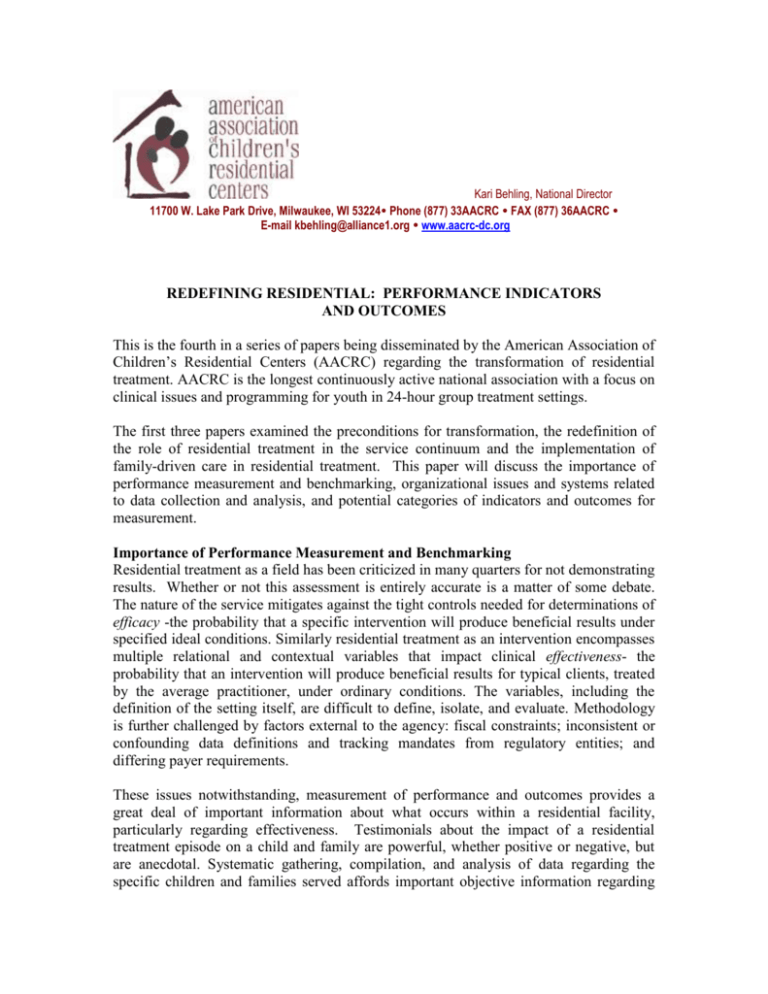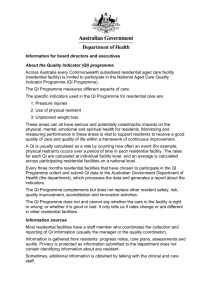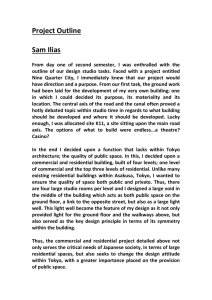AACRC`s 4th Paperoutcomes - Association of Children`s
advertisement

Kari Behling, National Director 11700 W. Lake Park Drive, Milwaukee, WI 53224 Phone (877) 33AACRC FAX (877) 36AACRC E-mail kbehling@alliance1.org www.aacrc-dc.org REDEFINING RESIDENTIAL: PERFORMANCE INDICATORS AND OUTCOMES This is the fourth in a series of papers being disseminated by the American Association of Children’s Residential Centers (AACRC) regarding the transformation of residential treatment. AACRC is the longest continuously active national association with a focus on clinical issues and programming for youth in 24-hour group treatment settings. The first three papers examined the preconditions for transformation, the redefinition of the role of residential treatment in the service continuum and the implementation of family-driven care in residential treatment. This paper will discuss the importance of performance measurement and benchmarking, organizational issues and systems related to data collection and analysis, and potential categories of indicators and outcomes for measurement. Importance of Performance Measurement and Benchmarking Residential treatment as a field has been criticized in many quarters for not demonstrating results. Whether or not this assessment is entirely accurate is a matter of some debate. The nature of the service mitigates against the tight controls needed for determinations of efficacy -the probability that a specific intervention will produce beneficial results under specified ideal conditions. Similarly residential treatment as an intervention encompasses multiple relational and contextual variables that impact clinical effectiveness- the probability that an intervention will produce beneficial results for typical clients, treated by the average practitioner, under ordinary conditions. The variables, including the definition of the setting itself, are difficult to define, isolate, and evaluate. Methodology is further challenged by factors external to the agency: fiscal constraints; inconsistent or confounding data definitions and tracking mandates from regulatory entities; and differing payer requirements. These issues notwithstanding, measurement of performance and outcomes provides a great deal of important information about what occurs within a residential facility, particularly regarding effectiveness. Testimonials about the impact of a residential treatment episode on a child and family are powerful, whether positive or negative, but are anecdotal. Systematic gathering, compilation, and analysis of data regarding the specific children and families served affords important objective information regarding the work that occurs as part of a residential treatment intervention and establishes credibility for individual organizations and the field. Benchmarking offers an important companion to performance measurement. It creates an opportunity for an organization to compare its performance, as measured on key indicators, with that of other similar entities. While performance measurement can identify effectiveness on a particular metric over time, benchmarking further contextualizes the data, comparing it to that of similar organizations providing care and treatment for similar children, youth, and families. In a culture in which continuous improvement of quality is valued, benchmarking can safeguard against myopic interpretations of organizational performance data and can incentivize the pursuit of excellence. For the field it offers the opportunity of identifying objectively determined standards and demonstrating individual or collective agency performance against these benchmarks. A growing number of organizations have invested in performance and outcome measurement and are producing important data about their work. Nonetheless, data collection and aggregation in the field is not systematic, generating a perceived and, to a degree, actual lack of evidence. The work we do is too important to ignore this issue. While the responsibility is shared with payers, government, and academia, we can assert leadership, as individual agencies and as a field, to establish performance measurement and benchmarking systems and practices that yield meaningful information about the results of a residential treatment intervention and key mediating indicators. Organizational and Industry Challenges Creating a culture that values and balances quantitative and qualitative information requires careful work on the part of leadership to evoke, support, and sustain key norms and values related to quality improvement and continuous learning. It involves: including stakeholders, especially staff, parents, youth, and community partners, in indicator identification and system design; ensuring that indicators are supported by available evidence and that the data collected is relevant; establishing and sustaining costeffective and efficient information systems; reinforcing data-driven process improvements; and using the products of performance measurement and benchmarking to provide timely feedback and to support staff in their work. The literature on organizational development offers a resource to residential facilities that identifies approaches to the creation of such a culture. Financial wherewithal is often an issue, but the investment is critical if an organization is to improve its programs, effectively demonstrate the effects of its work, market its services, and garner staff and community “buy-in”. Sustaining the effort depends to a significant degree on the establishment and renewal of meaningful indicators that are aligned with the mission, vision, values, and philosophy of the organization and with licensing and accreditation standards. The challenge for the field is to help establish common data sets across organizations and states. Although efforts have been confounded by difficulties agreeing upon data definitions and measurement specifications along with concerns about comparing programs serving differing populations, a set of broad outcome and indicator measures is emerging. The opportunity is ripe for the field of residential treatment to develop and/or embrace national indicators addressing the work occurring in programs around the country. Frameworks for Indicator Development As residential programs implement or refine their performance measurement systems, a basic framework may be helpful in guiding the identification and development of indicators and determining benchmarking priorities. One such framework contains four categories: Practice/Process Indicators – These measure processes and practices of care that occur in the course of a residential treatment episode, for example: areas that are problem prone, of high risk, or representing worrisome patterns (e.g. seclusion and restraint, medication management, elopements, incidents, and injuries); dimensions of family and youth involvement such as family inclusion in the milieu, youth participation in treatment, parent contact; continuum of care factors such as access to services and supports, participation of community partners, continuity of care, timeliness and comprehensiveness of diagnostic assessments, and discharge planning; and/or activities/practices sub-grouped by life domains (i.e. emotional, psychological, physical, social, academic, medical, nutritional, legal, spiritual, cultural, vocational). Functional Outcomes – These indicators reflect change in the child’s level of functioning, either during a residential episode, or afterwards as a result of the treatment intervention, as measured through valid and reliable instrumentation and processes. Family and community expectations are important considerations in identifying meaningful functional outcomes, which might include restrictiveness of living environment, school performance, legal involvement, peer relationships, severity of illness, etc. Perception of Care – These indicators measure the response and satisfaction of children, families, and the community regarding the services provided, using internally developed and/or nationally normed instruments. Organizational Indicators – These are measurements of organizational phenomena such as staff retention, job satisfaction, work environment, fiscal performance, safety programs, etc. These important dimensions of performance directly impact the quality of care, and can be correlated with practice, functional, or perception indicators. A useful taxonomy is being developed through the national Building Bridges initiative. This conceptualizes indicators related to the “bridges” between residential treatment and the family and community, organizing them chronologically: referral/admission; “during” residential treatment; discharge/transition; and throughout the process. The matrix differentiates standards- the presence of a set of conditions related to treatment- from indicators of quality that can be directly measured. It incorporates the categories identified above in one integrated design that can yield a common data set across the field but still allow for individualization within organizations. Measurement for a Redefined Residential Excellent work has been occurring in various places around the country to reconceptualize the role of residential treatment within the continuum of care and to design mechanisms with which to integrally link a residential intervention with other community services. As part of this work performance measures and outcomes that might be expected of a residential intervention are being proposed. Additionally the importance of collecting, aggregating, and analyzing data to allow for comparisons among providers of similar interventions across the system of care is being emphasized. The Building Bridges initiative, in which AACRC members have played important leadership roles, offers an opportunity for the field to come together in focusing its work on broadly shared goals and practices and in developing/implementing common measurements, in alignment with emerging federal and state policy, that demonstrate its importance and effectiveness, as well as its opportunities for improvement. AACRC believes that its member agencies and other residential facilities around the country must proactively embrace the challenge of performance and outcome measurement and benchmarking. Many are already doing so and have been for some time. Expanding this effort individually and collectively will help organizations firmly establish a redefined role in community systems of care, increase viability and credibility, and most importantly, improve quality and results for children and families. With any questions please contact the AACRC office at 1-877-332-2272.








